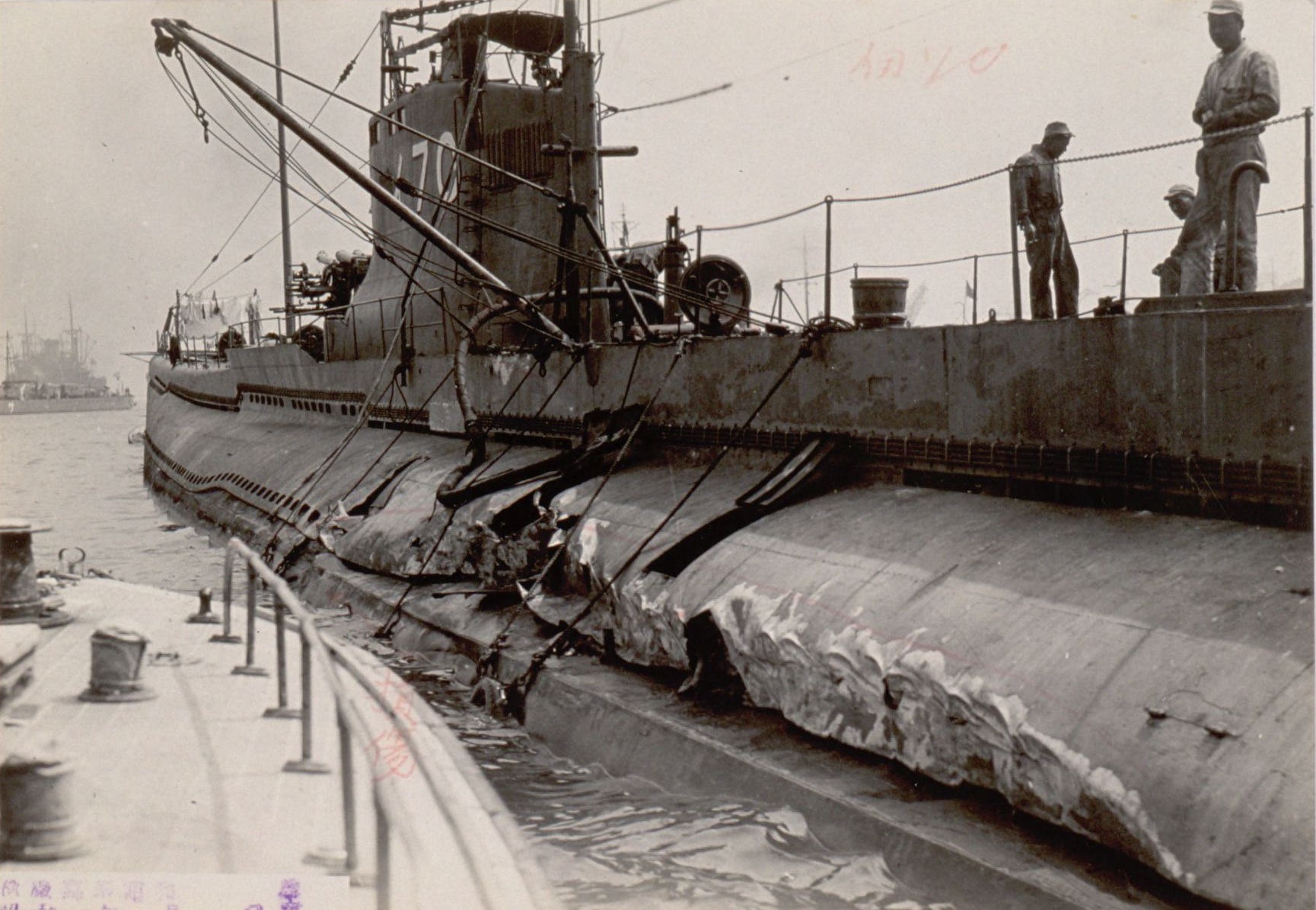SENSUIKAN!
 I-70 after 12 May 1941 collision
HIJMS Submarine I-70: Tabular Record of
Movement
I-70 after 12 May 1941 collision
HIJMS Submarine I-70: Tabular Record of
Movement
© 2001-2010 Bob Hackett & Sander Kingsepp
Revision 2
25 January 1933:
Laid down at Sasebo Navy Yard.
14 June 1934:
Launched. The ceremony is attended by Vice Admiral
(later Admiral, Navy Minister) Yonai Mitsumasa (29), the commandant of Sasebo
Naval Base.
28 February 1935:
LtCdr (Rear Admiral, posthumously) Iwagami Eiju
(46)(former division officer of NARUTO) is appointed the Chief Equipping
Officer (CEO).
9 November 1935:
I-70 is completed and attached to Kure Naval
District. She is assigned to SubDiv 12 as the new division flagship. LtCdr
Iwagami Eiju is the Commanding Officer.
1 December 1936:
LtCdr (Captain, posthumously) Ohata Tadashi
(50)(former CO of RO-67) is appointed the CO.
15 November 1938:
LtCdr (Captain, posthumously) Izu Juichi
(51)(former CO of I-123) is appointed the CO.
1 June-24 August 1939:
LtCdr Izu is appointed the CO of I-69 as
an additional duty.
24 August 1939:
Placed in third reserve. During a refit at Kure,
the submarine is fitted with a Type 93 passive sonar and an improved attack
computer.
LtCdr (later Captain) Inaba Michimune (51)(former CO of
CHIDORI/MANAZURU) is appointed the CO of I-69 (until 1 September) and I-70
as additional duty.
30 October 1940:
LtCdr (promoted Cdr 15 November; Captain,
posthumously) Sano Takao (50)(former CO of I-63) is appointed the CO.
26 January 1941:
Captain (Rear Admiral, posthumously) Nakaoka
Nobuki's (45), ComSubDiv 12 flag is transferred to I-69.
15-31 March 1941:
Cdr Sano is appointed the CEO of I-23 as
additional duty.
30 March 1941:
I-70 is reappointed the flagship of SubDiv 12.
12 May 1941:
I-69 collides with I-70. I-70 suffers a long gash
forward in her starboard tanks almost back to the conning tower and I-69 suffers
a damaged bow. Both submarines return to Yokosuka for repairs.
15 May 1941:
SubDiv 12's flag is transferred to I-68.
November 1941: Operation Z:
I-70 is in Vice Admiral Shimizu Mitsumi's
(former CO of ISE) Advance Expeditionary Force (Sixth Fleet) with Rear Admiral
(later Vice Admiral) Miwa Shigeyoshi's (former CO of CL KINU) SubRon 3 in
Captain (Rear Admiral, posthumously) Nakaoka Nobuki's (later CO of ATAGO)
SubDiv 12 with I-68 and I-69.
Admiral Shimizu convenes a meeting of all his commanders aboard his
flagship, light cruiser KATORI. Cdr Sano and the other commanders are briefed
on the planned attack on Pearl Harbor.
11 November 1941:
Departs Saeki in company of I-68.
20 November 1941:
Arrives at Kwajalein. Refuels and reprovisions.
23 November 1941:
Departs Kwajalein for Hawaii.
2 December 1941:
The coded signal "Niitakayama nobore (Climb Mt.
Niitaka) 1208" is received from Combined Fleet. It signifies that hostilities
will commence on 8 December (Japan time).[1]
7 December 1941: The Attack on Pearl Harbor:
SubRon 3's mission is to
reconnoiter and attack any ships that try to sortie from Pearl Harbor. SubDiv
12 is assigned to patrol between 25 and 50 miles S of Oahu. I-70 is stationed 10
miles from the entrance to Pearl Harbor. At midnight, she fails to answer the
radio call sent by KATORI. [2]
9 December 1941:
4 miles SW of Diamond Head, Oahu, Hawaii. At 0130
Cdr Sano reports an American carrier (USS ENTERPRISE (CV-6) arriving at Pearl
Harbor. This is the last signal received from I-70.
10 December 1941:
I-6 reports sighting a LEXINGTON-class aircraft
carrier and two cruisers heading NE. Vice Admiral Shimizu in KATORI at
Kwajalein orders SubRon 1 and other boats to pursue and sink the carrier.
121 miles NE of Cape Halava, Molokai, Hawaiian Islands. After 0600 in the
morning, Ens Perry L. Teaff's Douglas SBD-2 "Dauntless" dive-bomber of VS-6
from USS ENTERPRISE (CV-6) attacks I-70 on the surface and scores a near-miss
with a 1,000-lb bomb that damages the submarine, preventing her submerging.
In the afternoon, another SBD of VS-6 flown by Lt (jg) Clarence E.
Dickinson Jr. sights a surfaced submarine in the same area. Dickinson climbs to
5,000 ft for a diving attack. His plane is sighted from the submarine, which
commences a slow turn to starboard, opening fire from her 13-mm machine guns.
[3]
The bomb dropped from the "Dauntless" lands right beside the submarine,
amidships. Its explosion throws several gunners over board. I-70 stops and
starts to settle on the even keel, disappearing underwater about 45 seconds
after the explosion at 23-45N, 155-35W.
When Dickinson returns to the scene of the sinking, he sights four IJN
sailors flailing in the water. A bubble of oil and foamy water appears on the
surface, followed by two more bubbles, containing oil and debris.
I-70 is the first Japanese combatant ship sunk by United States aircraft
during World War II and the first fleet submarine lost in the Pacific War.
Sixth Fleet's headquarters tries to contact I-70, even after the other
subs of her division return to Kwajalein. The effort is unsuccessful. I-70 is
presumed lost with all 93 hands off Hawaii.
15 March 1942:
Removed from the Navy List.
Authors' Notes:
[1] Mt. Niitaka, located in Formosa (now Taiwan), was then
the highest point in the Japanese Empire.
[2] On 7 Dec '41, while en route from ENTERPRISE to Pearl Harbor with a
flight of 18 planes, Lt Dickinson was shot down by an A6M2 "Zeke" fighter of the
Pearl Harbor Attack Force. His rear gunner was KIA, but Dickinson survived to
sink I-70 three days later.
[3] Dickinson reported that the submarine he attacked had fired back from
no less than two deck guns, while I-70 had only one.
Thanks go to Dr. Higuchi Tatsuhiro of Japan.
Photo credit goes to Matthew Jones.
– Bob Hackett and Sander Kingsepp.
Back to Submarine
Page





